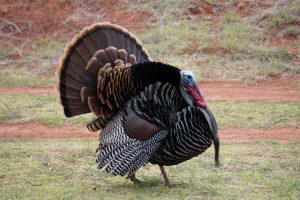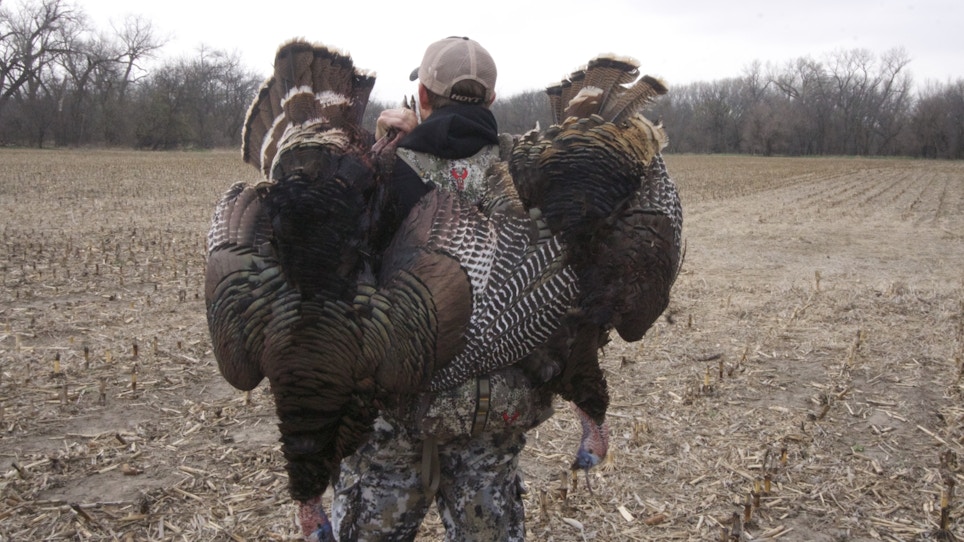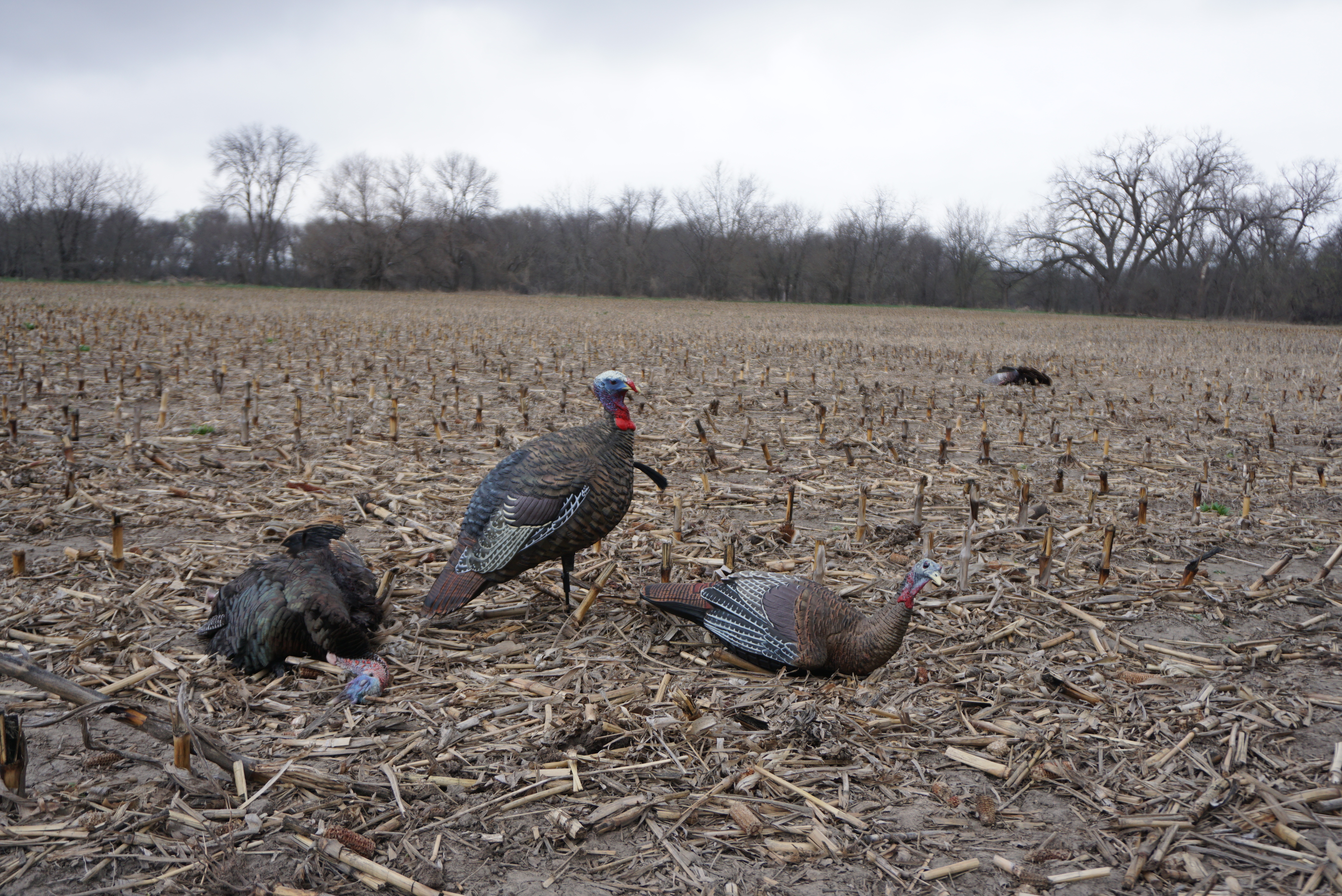Last spring, I hunted wild turkeys in three states that I don’t have residency in. I did it for a grand total of $962.89.
You can try and border hop for deer or elk on this budget, but let me save you some time — it’s not going to happen. But wild turkeys on a budget? That’s quite doable. I live in Colorado, so I’ll breakdown budget hunts in states that share borders with my home state.
Not able to hunt these same states? Just apply the tips and principles in this article when researching close-to-your-home destinations. In recent years, state game and fish websites have been vastly improved. Only a little web time is required to start planning your 2017 turkey extravaganza.
Related: How To Take Down A Grand Slam Turkey
Nebraska: Don’t Overlook Those Smaller Tracts
Touching Colorado’s northeast border is the Cornhusker State, a destination that permits nonresident turkey hunters to pocket three tags and boasts one of the most robust turkey populations in the country. Yes, Nebraska is a must-visit turkey locale. The archery-only season kicks off on March 25 every year, and the state harbors more than 500,000 acres of public land. If you’re looking to take a youngster along, youth permits can be purchased for only $7.
In addition, the Nebraska Game and Parks has an interactive website that provides traveling hunters access to its Public Land Atlas. Just go to www.outdoornebraska.gov, click on the “Where To Hunt” tab, and select the “View The Atlas” tab. The map is divided into small regions so you can easily navigate and find the destinations that you’re looking to bowhunt. Over the years, I have taken a number of birds on public property in Nebraska. Avoid the shotgun opener, and the only company you may find on your public dirt is that of a few willing-to-work springtime noisemakers.
Also, don’t look past those smaller 40- to 80-acre tracts. In 2013, I killed a pair of longbeards on a 54-acre piece of walk-in. The larger 1,234-acre tract down the road had a full parking lot, but the only traffic this little gem sported was some bristly beards.
Another great option when looking to hunt a new turkey state for the first time is social media networking. Over the years, I’ve traded hunts (e.g., a pronghorn for turkey access) with a pair of Nebraska residents. Before that, I exchanged Colorado public-land elk info for a few walk-in hotspots in Nebraska with a Facebook friend. This past season, I hooked my up with my friend Terron Bauer at his home for a Nebraska turkey hunt that I will never forget. On the first evening of the hunt, I arrowed a jake, and moments later, a monster tom that flogged both the dead jake and the Avian-X jake decoy was anchored.
Nebraska: The Breakdown
- License Cost: $97 per turkey tag. I purchase two. Total tag cost = $194.
- Gas: Average mileage to both public land and private access = 200 miles. Average miles in truck during the hunt = 125. Total average miles traveled = 525. Total average cost in gas at $2.25 per gallon = $70.
- Food: I eat very simply on my out-of-state bowhunts, and, to keep food costs down, I don’t eat out on trips. My food bill for my 2016 Nebraska adventure, after buying Terron and his wife, Brooke, lunch, was $108.
- Lodging: I stayed rent-free at Terron’s house on this hunt, but when I’m on a public-land adventure, I tent camp to avoid motel fees. Cost of lodging = $0.
- Total turkey hunt cost: $372
Kansas: Interactive Atlas for Out-of-Staters
Packed with both Rio Grande and Eastern birds, the Sunflower State isn’t just a top-notch whitetail destination. Like its neighbor to the north, Kansas boasts an ultra-informative website at www.ksoutdoors.com that features an interactive Spring Hunting Atlas. What intrigued me from the get-go about this particular atlas is the color-coded legend. Those areas highlighted/outlined in bright yellow are open to walk-in-access hunting from April through May. You don’t need a NASA pedigree to conclude that these areas boast huntable populations of springtime Toms. This legend helps you narrow your search when looking for a turkey hotspot. 
What I also appreciate about the interactive atlas is the fact that it can be viewed in aerial mode. This gives you the ability to zoom in on possible turkey haunts and identify key terrain features. On more than one occasion, after looking at my aerial view, I’ve identified likely roost, feeding and mid-day strut zones.
When I arrive at the given property and put boots on the ground, I pull out my printed, marked-up aerial image. That immediately gives me multiple jumping-off points. For those that don’t like to carry laminated maps and prefer the ease of a cellphone or GPS, the Sunflower State has you covered. After clicking on the “Spring Turkey Atlas” tab on the website, take a glance at the ArcGIS Explorer App for smartphones and tablets. This free, downloadable app brings the walk-in hunting access (WIHA) tracts to your mobile device. Pretty cool, huh?
Kansas: The Breakdown
- License Cost: $87.50. I purchase the Nonresident COMBO Permit/Game Tag before March 31 and save on costs. Then I buy a second turkey tag for $32.50. Total tag cost = $120.
- Gas: Average mileage to both public land and private access = 345 miles. Average miles on truck during the hunt = 175. Total average miles traveled = 865. Total average cost in gas at $2.25 per gallon = $132.24.
- Food: My food bill for my 2017 Kansas adventure was $104.67.
- Lodging: It was a little brisk, but I camped for four nights at $8 per night at nearby Kansas Department of Wildlife, Parks and Tourism (KDWPT) state park. I also purchased a $25 annual vehicle parking permit, as I do every year. This permit is good for any KDWPT State Park.
- Total turkey hunt cost: $281.67
Related: How To Properly Prep Turkey Calls
Bonus Tip
According to KDWPT biologists, Kansas is currently experiencing a “turkey boom,” especially in the state’s northeast and southeast regions where the Eastern subspecies dwells. This is a species that has boasted a skyrocketing population over the past five years. Rio Grande birds roam the western two-thirds of the state, and these areas continue to sport a healthy population of birds as well.
Typically, the Kansas springtime archery-only season kicks off during the first week in April. The 2017 archery-only season is set to run from April 3-11. This is an awesome opportunity to hunt often unpressured public land. If you want to purchase a second turkey tag, you can add yet another set of drumsticks to the freezer if hunting units 1, 2, 3, 5 or 6.
Oklahoma: Aim For Late-Season Hunting
The turkey-rich Sooner State is a great springtime destination. Riddled with wildlife management areas (WMA), national grasslands and U.S. Army Corps of Engineers’ land, Oklahoma offers traveling turkey hunters no shortage of room to roam, and finding these areas is ultra-easy. Simply go to www.wildlifedepartment.com, click the “Where to Hunt” tab (which showcases an image of a pair of velvet bucks), click the “Wildlife Management Areas” tab, select a region of the state you’re looking to hunt, and then select individual areas within that region.
Upon clicking on a specific WMA, you will be instantly inundated with a plethora of information. An area description that includes total acreage, phone contact information and driving directions will be at your fingertips. You will also be able to read about the game species that dwell in the area and their current population status. That'll give you an idea about the hunt pressure for that particular species. Sweetening the pot, the Oklahoma Department of Wildlife Conservation provides information about camping facilities and a printable map of the selected WMA.
The first time I hunted an Oklahoma WMA for turkey was in the fall of 2014. I was hunting deer in the area and wanted to add an additional tag to my pocket, so I pulled all of the above-mentioned information up on my cellphone, looked at the map, found a spot, walked in and skewered a bird. I returned the following spring and repeated my success.
Looking at current turkey population numbers and distribution is also a snap, and doing so should be a big part of your pre-season planning. Simply click on the “What to Hunt” tab (which has an image of several strutting and semi-strutting jakes), click on the “Turkey” tab and then scroll down to “Wild Turkey Fast Facts.” My favorite tabs under this section include “Current Wild Turkey Distribution,” “Turkey Management in Oklahoma” and “Current Wild Turkey Population Estimates.”
Oklahoma doesn’t currently have an archery-only spring turkey season, but bowhunters will be able to get into the woods any time from April 6, 2017 to May 6, 2017. I know what you’re thinking: shotgun hunters will rule those woods, right? This may be true during the first part of the season, but visit your chosen WMA during the latter half of the season and you’ll likely find few hunters and plenty of longbeards.
Oklahoma: The Breakdown
- License Cost: My 2016 nonresident hunt license was $142. I then purchased a pair of turkey tags at $10 a pop. The total tag cost = $162.
- Gas: Average mileage to both public land and private access = 268 miles. Average miles on truck during the hunt = 200. Total average miles traveled = 736. The total average cost with gas set at $2.25 per gallon = $112.22.
- Food: My food bill for my 2016 Oklahoma adventure was $35. Cheap, right? That’s because through social networking and trading hunts, I’ve developed an incredible friendship with a couple in the area I hunt. They provide me with free room and board. I repay the favor when they come to Colorado.
- Lodging: I used to tent camp at the WMA I hunt, but now I stay with my Sooner State friends. Either way, I’ve never spent a dime to stay in Oklahoma.
- Total turkey hunt cost: $309.22
By hunting three states that border my home state, I ended up with a total of six out-of-state turkey tags in 2016. How’d I do? I came back with four wild turkeys.
Related: A Southern Turkey Adventure







